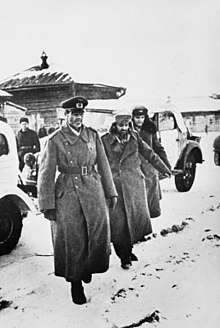Wilhelm Adam
| Wilhelm Adam | |
|---|---|

Surrender at Stalingrad, 1943: Colonel Wilhelm Adam (right) with Lt-Gen. Arthur Schmidt (centre) and Field Marshal Friedrich Paulus (left)
|
|
| Born |
28 March 1893 Eichen, now a part of Nidderau, German Empire |
| Died | 24 November 1978 (aged 85) Dresden, East Germany |
| Allegiance |
|
| Service/branch |
Army Land forces |
| Years of service | 1914–18 (Reichswehr) 1934–45 (Wehrmacht) 1952–56 (KVP) 1956–58 (NVA) |
| Rank |
Oberstleutnant (Wehrmacht) Generalmajor (NVA) |
| Unit | XXIII Army Corps |
| Battles/wars |
World War II |
| Awards | Knight's Cross of the Iron Cross |
| Other work | politician |
Wilhelm Adam (28 March 1893 in Eichen, now a part of Nidderau – 24 November 1978 in Dresden) was a career military officer who served in three German Armies and later became an East German politician.
Born in 1893, Adam's attended from 1908 to 1913 the teacher training college in Schlüchtern. Adam and his wife had two children, a daughter and a son. Their son Heinz was killed in France at the start of World War II on 16 May 1940. From 1 October 1913, Adam served as a one-year volunteer in military service with the 5th Company of the 2nd Nassau Infantry Regiment 88. At the beginning of the First World War on 8 August 1914, now a corporal, he moved to the front. He was wounded on 16 September 1914 and sent to a Protestant hospital in Düsseldorf. returning to the replacement battalion of his regiment 10 days later. On 1 April 1915 he was promoted to sergeant. From April to May 1915 he took an officer candidate course in Lockstedter and upon graduation on 22 May was promoted to lieutenant. On 14 June, he became a Zugführer (platoon leader) at 1st Recruits Depot of the XVI Army Corps. On 5 October 1915 he was assigned to the 5th Company of the Infantry Regiment "Graf Werder“ (4. Rheinisches) Nr. 30 . After an illness in July 1916, which he recovered from in a field hospital at Germersheim, he was transferred to the 1st Replacement Battalion of the 2nd Nassau Infantry Regiment 88. On 28 September 1916 he became the commander of a machine gun company of the 424th Infantry Regiment. On 28 October 1916, he was appointed the aide to the Landwehr Infantry Brigade 70, a position he held until the end of the war. He was dismissed from the Army as a Lieutenant on 31 January 1919.
From 1919 to 1929, Adam was working as a senior vocational school teacher at the army's vocational school in Langenselbold, Hesse, and from 1929 to 1934 in Weimar, Thuringia. Alongside these duties, Adam also studied from 1922 to 1924 at the university in Frankfurt am Main and completed the examination for middle school teachers in 1927. In 1919 he became a member of the Langenselbold Military Association and in 1920 of the Young German Order. In 1923, Adam joined the Nazi Party and was involved that same year in the Beer Hall Putsch. In 1926, Adam left the Nazis and joined the German People's Party (DVP), with whom he stayed until 1929.
...
Wikipedia
